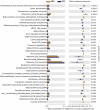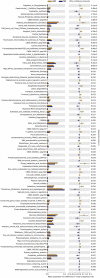Bacterial and Fungal Adaptations in Cecum and Distal Colon of Piglets Fed With Dairy-Based Milk Formula in Comparison With Human Milk
- PMID: 35401465
- PMCID: PMC8989072
- DOI: 10.3389/fmicb.2022.801854
Bacterial and Fungal Adaptations in Cecum and Distal Colon of Piglets Fed With Dairy-Based Milk Formula in Comparison With Human Milk
Abstract
Exclusive breastfeeding is recommended to newborns during the first 6 months of life, whereas dairy-based infant formula is an alternative nutrition source offered to infants. Several studies demonstrated that breastfed infants have a different gut bacterial composition relative to formula-fed infants. In addition, animal models have shown that human milk (HM)-fed piglets had a distinct intestinal bacterial composition compared with milk formula (MF)-fed piglets. However, the gut fungal composition and the interactions with the bacterial community in breastfed compared with formula-fed infants remain to be investigated. In an attempt to evaluate such differences, we used an animal model to perform a shotgun metagenomics analysis on the cecal and distal colon contents of neonatal piglets fed with pasteurized HM or a dairy-based infant formula (MF) during the first 21 days of life. At postnatal day 21 (PND 21), a subset of piglets from each diet group (n = 11 per group) was euthanized. The remaining piglets in each group were weaned to a solid diet and euthanized at PND 51 (n = 13 per group). Large intestine contents (i.e., cecum and distal colon) were subjected to shotgun metagenomics analysis. The differential taxonomic composition of bacteria and fungi and the predicted functional gene profiling were evaluated. Bacteroidetes, Firmicutes, Proteobacteria, and Actinobacteria are the most abundant bacterial phyla observed in piglets at PND 21 and PND 51. In the large intestine at PND 21 and PND 51, Proteobacteria phylum was significantly higher in MF-fed group, and species Burkholderiales bacterium of phyla was significantly higher in MF group relative to HM group. In addition, in HM group, several Lactobacillus spp. and Bacteroides spp. were higher relative to MF group in the large intestine at PND 21 and PND 51. Fungal genus Aspergillus was higher in MF, whereas Malassezia was lower relative to HM group. Persistent effects of the neonatal diets were observed at PND 51, where alpha- and beta-diversity differences were detected for bacterial and fungal species in the large intestine. Overall, our findings indicate that neonatal diet affects the large intestinal microbial community during the exclusive milk-feeding period, as well as after the introduction of the complementary food.
Keywords: bacteria; distal gut; fungi; human milk; milk formula.
Copyright © 2022 Elolimy, Rosa, Tripp, Zeineldin, Bowlin, Randolph, Robeson and Yeruva.
Conflict of interest statement
The authors declare that the research was conducted in the absence of any commercial or financial relationships that could be construed as a potential conflict of interest.
Figures






Similar articles
-
Neonatal Diet Impacts Bioregional Microbiota Composition in Piglets Fed Human Breast Milk or Infant Formula.J Nutr. 2019 Dec 1;149(12):2236-2246. doi: 10.1093/jn/nxz170. J Nutr. 2019. PMID: 31373372 Free PMC article.
-
Human Milk-Fed Piglets Have a Distinct Small Intestine and Circulatory Metabolome Profile Relative to That of Milk Formula-Fed Piglets.mSystems. 2021 Feb 9;6(1):e01376-20. doi: 10.1128/mSystems.01376-20. mSystems. 2021. PMID: 33563783 Free PMC article.
-
Neonatal Diet Impacts the Large Intestine Luminal Metabolome at Weaning and Post-Weaning in Piglets Fed Formula or Human Milk.Front Immunol. 2020 Dec 7;11:607609. doi: 10.3389/fimmu.2020.607609. eCollection 2020. Front Immunol. 2020. PMID: 33365033 Free PMC article.
-
The Metagenomic and Metabolomic Profile of the Infantile Gut: Can They Be "Predicted" by the Feed Type?Children (Basel). 2022 Jan 25;9(2):154. doi: 10.3390/children9020154. Children (Basel). 2022. PMID: 35204875 Free PMC article. Review.
-
Nutrition, growth, and allergic diseases among very preterm infants after hospital discharge.Dan Med J. 2013 Feb;60(2):B4588. Dan Med J. 2013. PMID: 23461996 Review.
Cited by
-
Impact of diet on the gut mycobiome of Hong Kong Chinese infants.Comput Struct Biotechnol J. 2025 Feb 14;27:661-671. doi: 10.1016/j.csbj.2025.02.006. eCollection 2025. Comput Struct Biotechnol J. 2025. PMID: 40061440 Free PMC article.
-
Fungi in the Gut Microbiota: Interactions, Homeostasis, and Host Physiology.Microorganisms. 2025 Jan 2;13(1):70. doi: 10.3390/microorganisms13010070. Microorganisms. 2025. PMID: 39858841 Free PMC article. Review.
References
LinkOut - more resources
Full Text Sources
Miscellaneous

